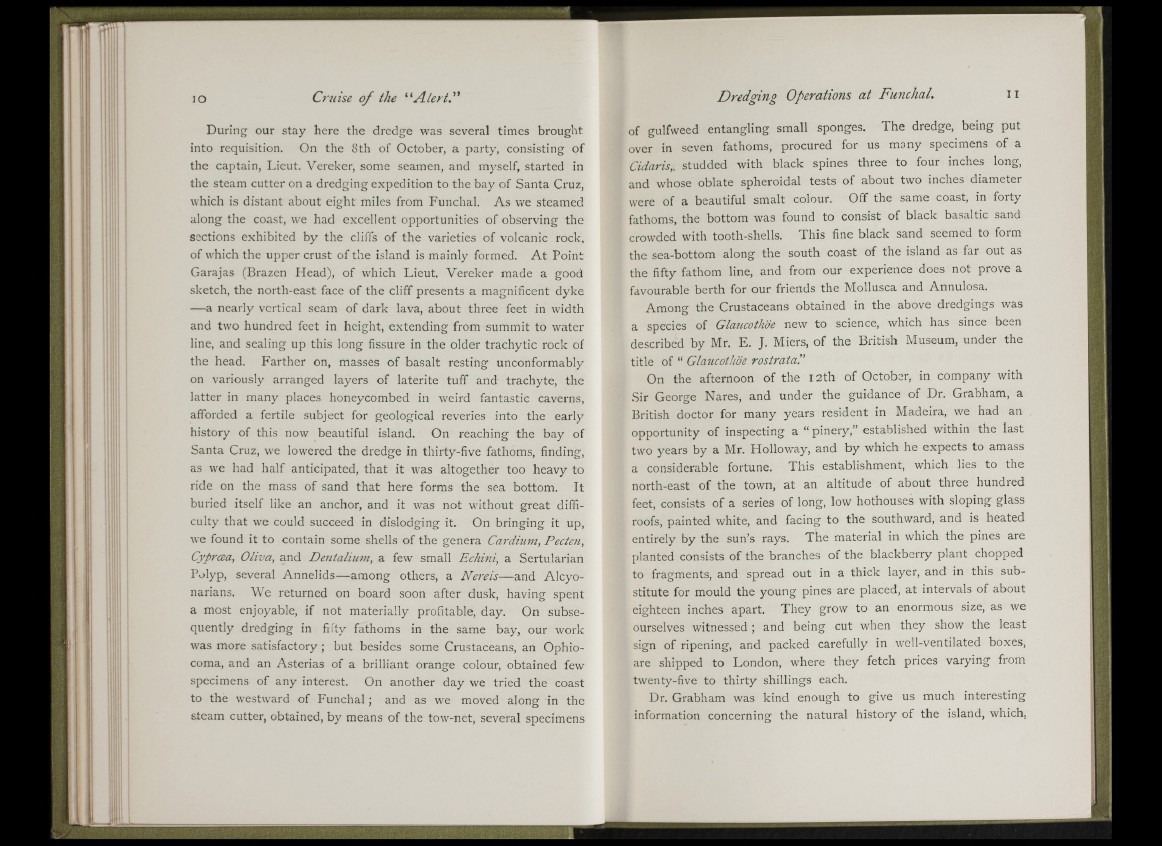
lO Cruise o f the Ale rt.”
During our stay here the dredge was several times brought
into requisition. On the 8th of October, a party, consisting of
the captain, Lieut. Vereker, some seamen, and myself, started in
the steam cutter on a dredging expedition to the bay of Santa Cruz,
which is distant about eight miles from Funchal. As we steamed
along the coast, we had excellent opportunities of observing the
sections exhibited by the cliffs of the varieties of volcanic rock,
of which the upper crust of the island is mainly formed. A t Point
Carajas (Brazen Head), of which Lieut. Vereker made a good
sketch, the north-east face of the cliff presents a magnificent dyke
— a nearly vertical scam of dark lava, about three feet in width
and two hundred feet in height, extending from summit to water
line, and sealing up this long fissure in the older trachytic rock of
the head. Farther on, masses of basalt resting unconformably
on variously arranged layers of laterite tuff and trachyte, the
latter in many places honeycombed in weird fantastic caverns,
afforded a fertile subject for geological reveries into the early
history of this now beautiful island. On reaching the bay of
Santa Cruz, we lowered the dredge in thirty-five fathoms, finding,
as we had half anticipated, that it was altogether too heavy to
ride on the mass of sand that here forms the sea bottom. It
buried itself like an anchor, and it was not without great difficulty
that we could succeed in dislodging it. On bringing it up,
we found it to contain some shells of the genera Cardhim, Pecten,
Cyproea, Oliva, and Dentalium, a few small Echini, a Sertularian
Polyp, several Annelids— among others, a Nereis— and Alcyo-
narians. We returned on board soon after dusk, having spent
a most enjoyable, if not materially profitable, day. On subsequently
dredging in fifty fathoms in the same bay, our work
was more satisfactory ; but besides some Crustaceans, an Ophio-
coma, and an Asterias of a brilliant orange colour, obtained few
specimens of any interest. On another day we tried the coast
to the westward of Funchal ; and as we moved along in the
steam cutter, obtained, by means of the tow-nct, several specimens
DredAng Operations at Funchal. 11
of gulfweed entangling small sponges. The dredge, being put
over in seven fathoms, procured for us many specimens of a
Cidaris,. studded with black spines three to four inches long,
and whose oblate spheroidal tests of about two inches diameter
were of a beautiful smalt colour. Off the same coast, in forty
fathoms, the bottom was found to consist of black basaltic sand
crowded with tooth-shells. This fine black sand seemed to form,
the sea-bottom along the south coast of the island as far out as
the fifty fathom line, and from our experience does not prove a
favourable berth for our friends the Mollusca and Annulosa.
Among the Crustaceans obtained in the above dredgings was
a species of Glaucothbe new to science, which has since been
described by Mr. E. J. Miers, of the British Museum, under the
title of “ Glaucothde rostrata!'
On the afternoon of the 12th of October, in company with
.Sir George Nares, and under the guidance of Dr. Grabham, a
British doctor for many years resident in Madeira, we had an
opportunity of inspecting a “ pinery,” established within the last
two years by a Mr. Holloway, and by which he expects to amass
a considerable fortune. This establishment, which lies to the
north-east of the town, at an altitude of about three hundred
feet, consists of a series of long, low hothouses with sloping glass
roofs, painted white, and facing to the southward, and is heated
entirely by the sun’s rays. The material in which the pines are
planted consists of the branches of the blackberry plant chopped
to fragments, and spread out in a thick layer, and in this substitute
for mould the young pines are placed, at intervals of about
eighteen inches apart. They grow to an enormous size, as we
ourselves witnessed ; and being cut when they show the least
sign of ripening, and packed carefully in well-ventilated boxes,
are shipped to London, where they fetch prices varying from
twenty-five to thirty shillings each.
Dr. Grabham was kind enough to give us much interesting
information concerning the natural history of the island, which,
if.'